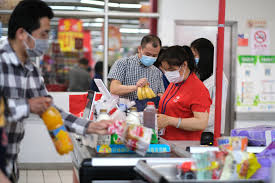>>REAL-TIME UPDATES IN THE WIRE. CLICK HERE<<<
China’s consumer prices were flat in September, while factory gate prices saw annual declines slow for a third month — pointing to the uneven post-Covid recovery in the world’s second-largest economy that may require further policy support.
The consumer price index (CPI) was unchanged in September from a year earlier, according to data from the National Bureau of Statistics showed, missing the forecast for a 0.2% gain in a Reuters poll and the 0.1% gain in August.
Food prices dropped 3.2% from a year earlier, extending a decline by 1.5 percentage points from August and dragging down the CPI. Pork prices shrank 22%, a sharper decline than a 17.9% drop in August.
In particular, the price of pork — a key staple meat in Chinese diets — tumbled 22% last month from a year ago. That’s as the price of livestock and meat collectively dropped 12.8% and the price of fresh vegetables fell 6.4%.
Due to ample supply before the Mid-Autumn Festival and the National Day holiday, the growth of food prices lower than the historical average, the NBS said.
Non-food price grew by 0.2% year over year in September, in line with the growth in August, it said.
Driven by higher global oil prices, China’s gasoline price grew by 2.4%. Service prices fell 0.1%, compared to 0.1% rise in the previous month, with prices of air ticket, hospitality and tourism products sliding 12.6%, 5.5% and 3.4%, respectively, due to the end of summer travel season, it said.
Core inflation, excluding food and fuel prices, was 0.8%, in line with August, showed the data.
Month-on-month, consumer prices edged up 0.2% in September, with food prices increasing 0.3% — representing a decrease of 0.2 percentage points from August’s print compared to the previous month.
“The market supply is relatively sufficient before the Mid-Autumn Festival and National Day this year, and the food price increase is slightly lower than the historical average for the same period,” said Dong Lijuan, statistician at the National Bureau of Statistics.
The producer price index (PPI) fell 2.5% from a year earlier, the 12th straight month in negative territory though the pace of decline slowed from August. Economists had predicted a 2.4% fall in September.
Dong attributed the decline to an overall downward trend in international commodity prices, weak demand in domestic and foreign industrial product markets, and the high comparison base during the same period last year.

